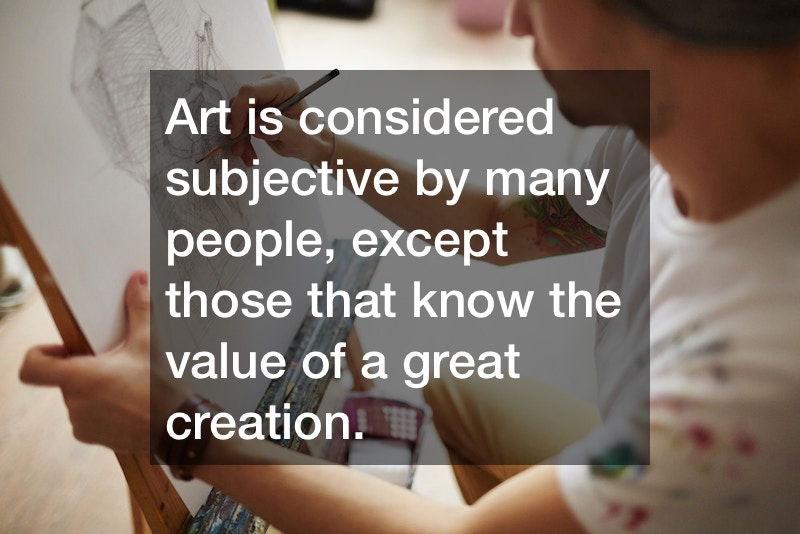
Art is considered subjective by many people, except those that know the value of a great creation. They understand the business side of this industry, which is often disregarded by the beauty of a sculpture, portrait, or piece created by the artist. They know what a custom framing order costs and how to make the proper investments.
It’s time for you to learn the intricacies of this world, but first, you’re going to need some background knowledge. You should understand basic art history, but knowing about materials is also vital. For example, most people don’t know the difference between a premium giclee print and printing on rag paper and how it can affect the price of a painting.
You must understand why some round art prints are even more expensive than huge canvases and why. You also should know the archival pigment print cost and why it’s often used by museums for their best work. Once you gain that knowledge, you can start searching for pieces with a better understanding of fine art. However, no research will be more valuable than visiting galleries and talking to curators along with artists and collectors.
Let’s find out more about the business of fine art.
Art is universal in the human race, and all cultures create art in many different forms. Art may be music, dance, jewelry, poetry and literature, and certainly sculptures and graphic art on a canvas or paper. Today’s art business is a robust one, and nearly any city or region today will have its very own art scene. In the United States in particular, tourists in a city such as NYC, Miami, Boston, or Los Angeles may look for the best art gallery around and find out what the local art is like. They can enter a query into a phone such as “fine art gallery nearby” or even “Latin artist gallery near me” and find a fine art gallery that suits their interests. At a fine art gallery, the art may be general contemporary art, along with pieces from particular artists such as popular Latin or African American artists. Such ethnic art is a minority at a typical fine art gallery, but it’s a growing sector. What is there to know about visiting a fine art gallery today, and what sort of effect does fine art have on the human mind and body? The answers may be surprising.
The Business and Science of Art
Art is subjective, and famously so, as it takes an infinite variety of forms. Art is human creative expression, and is thus as diverse as the human race itself. Still, there are some ways to study general trends of art today, and the numbers point to a strong economy for fine arts. As of 2017, for a recent example, the worldwide art market had an estimated value of nearly $64 billion USD, and art collections can often be quite large and diverse in their contents. It is believed that American art in particular is common, and it appears in around 40% of all art collections around the globe. And 53% of art collections, just over half of them, include over 500 pieces, often including paintings in particular. Paintings are the most popular form of art today, appearing in 83% of collections compared to 15% for drawings, collages, and works on paper. And in the United States in particular, some 113,000 nonprofit arts organizations are in operation today, employing some 2.2 million artists in the work force.
All this effort is not going to waste. Nearly everyone enjoys art, and a museum guest doesn’t have to be an esteemed art professor or critic to appreciate some fine art. In fact, studies show that all people can benefit from viewing art in terms of health. In particular, findings show that viewing art can reduce stress in a person, and viewing attractive art activates the brain in a similar way when a loved one is seen. Many people leaving a museum after at least half an hour of art viewing report feeling more relaxed and happy. Some studies even suggest a reduced level of cortisol, the stress hormone, after art viewing. In this way, art can have a therapeutic effect on its viewer.
Where to Place Art
Naturally, many art pieces appear in galleries and museums large and small, but that is not the only place where art belongs. Many public establishments have art in them, and nearly always for the benefit of guests and patrons. Restaurants and cafes may have framed paintings, prints, and photos on their walls to add to the decor and help set the establishment’s theme and mood. A library or doctor or dentist’s waiting office may also have art in them, and the same is true of a hotel lobby. This, combined with certain lighting fixtures and furniture, can give a hotel a desired homely feel.
Art belongs in the workplace, too. Attractive art can help stimulate creativity and flexible thinking in office employees, something a manager is bound to appreciate. Creative visuals as a whole can have this effect, including framed art, potted plants, and innovative arrangements of tables and chairs. Plain and stuffy work spaces may result in stale minds, but a creative one has the opposite effect. An art consultant can be hired to help with this, and an office (or other establishment) can support local, growing artists by showcasing their paintings and photography work for all to see.

